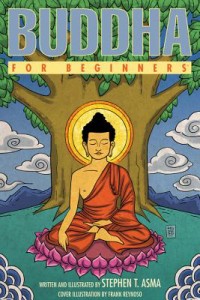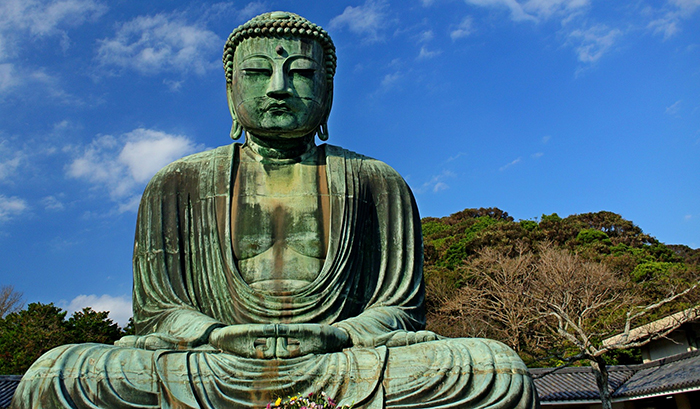A review of Buddha for Beginners by Steven T. Asma.
 Say “Buddhism,” and the free-association machine will gin up everything from the Dalai Lama, self-immolating monks, and robed meditators to Zen and the Art of Motorcycle Maintenance, Kung Fu movies, and that chubby laugher with no hair. Or, perhaps, “Buddhism” will simply considered as yet another category among the world’s major religions, like Christianity, Judaism, Islam, Hinduism.
Say “Buddhism,” and the free-association machine will gin up everything from the Dalai Lama, self-immolating monks, and robed meditators to Zen and the Art of Motorcycle Maintenance, Kung Fu movies, and that chubby laugher with no hair. Or, perhaps, “Buddhism” will simply considered as yet another category among the world’s major religions, like Christianity, Judaism, Islam, Hinduism.
But just as Christianity can’t be simply reduced to affectionate pastiche (hello, buddy Jesus!), and sweeping pop-culture generalizations – or treated as a categorical, conceptually-unified block – Buddhism is an umbrella spanning a rich diversity of ideas and practices flourishing in 2,500 years of history.
This is to be done by one skilled in aims
who wants to break through to the state of peace:
Be capable, upright, & straightforward,
easy to instruct, gentle, & not conceited,
content & easy to support,
with few duties, living lightly,
with peaceful faculties, masterful,
modest, & no greed for supporters.Do not do the slightest thing
that the wise would later censure.Think: Happy, at rest,
may all beings be happy at heart.
Whatever beings there may be,
weak or strong, without exception,
long, large,
middling, short,
subtle, blatant,
seen & unseen,
near & far,
born & seeking birth:
May all beings be happy at heart.Let no one deceive another
or despise anyone anywhere,
or through anger or irritation
wish for another to suffer.As a mother would risk her life
to protect her child, her only child,
even so should one cultivate a limitless heart
with regard to all beings.
With good will for the entire cosmos,
cultivate a limitless heart:
Above, below, & all around,
unobstructed, without enmity or hate.
Whether standing, walking,
sitting or lying down,
as long as one is alert,
one should be resolved on this mindfulness.
This is called a sublime abiding
here & now.Not taken with views,
The Buddha, Karaniya Metta Sutta, translated from the Pali by Thanissaro Bhikkhus
but virtuous & consummate in vision,
having subdued desire for sensual pleasures,
one never again
will lie in the womb.
Buddha for Beginners, by Columbia College Professor of Philosophy and Distinguished Scholar Steven Asma, isn’t about “Buddhism” when by “Buddhism” we mean the ways in which the Buddha’s teachings have found expression in different and idiosyncratic cultural practices. In this sense, “Buddhism” is a manifestation of that most fundamental human instinct: The taxonomic impulse to label everything and, for better and worse, confine everything to their labels. Prof. Asma doesn’t condemn these many cultural Buddhisms and their corresponding Buddhists as rightly or wrongly labeled. But he is willing to do what few primers in the field of religious studies are willing to do, namely, set aside the contrived impartiality that treats every set of philosophical perspectives as more or less equally valid.
With the Buddha himself, Siddharta Gautama, as his focal point (hence the book’s title), Prof. Asma demarcates those schools of thought that correspond to the core teachings on the liberation from suffering (“enlightenment”) and those that veer off tangentially — some to the point that they, well, miss the point. Hence, we have Theravadan Buddhism whose doctrinal texts are the Pali Canon, the oldest transcriptions of the Buddha’s teachings from an oral tradition, distinguished from the True Sect of the Pure Land, which boils down to the very un-Buddha like doctrine of repeating a mantra to gain entry into heaven. In explaining the Buddha’s core teachings, rooted in psychology and an empirical approach that many might find surprising (especially since it is very much at odds with ritual and worship), Prof. Asma explores how these novel insights bumped up against the prevailing Hindu metaphysics of his time, refused to indulge speculation on metaphysical questions such as God(s) and the afterlife, and created a new practice-driven framework for living in the world that rejects the extremes of asceticism and hedonism. It is here that readers will be introduced to key teachings like the Four Noble Truths, which includes the Eightfold-path to enlightenment, as well as challenging concepts such as karma and “emptiness,” a key concept articulated by the 2nd CE philosopher Nagajurna and adopted by Zen, among many schools.
For those interested in a broad, uncritical overview of Buddhism both with and without quotation marks, Huston Smith and Philip Novak’s book Buddhism: A Concise Introduction is recommended. The value of Prof. Asma’s accessible primer comes from his willingness to call the proverbial spade a spade instead of merely sprinkling sugar around. For instance, Prof. Asma quite rightly points out that the emptiness concept in the Mahayana branch of Buddhism led to problematic ideas the Buddha rejected: “Some Buddhist philosophers fell back into the earlier metaphysics of “two worlds”: One, the day-to-day physical world of our experience; and two, the transcendental unspeakable Absolute (or emptiness.). When compared to Christian theology, in which “God reaches down to the human realm,” this approach to Buddhism has a human reaching up “to a nonpersonal transcendent Absolute.” As Prof. Asma points out, “No matter what banner is paraded under, this two-world metaphysics is not Buddhism.”
The significance of Prof. Asma’s critique, then, isn’t as a call for fundamentalist purity, but as a demand for honesty first and foremost. If some “Buddhist” schools of thought want to posit a “pantheon of divinities, deities to intone in times of trouble, to be sacrificed to, to be prostrated before, and to be bribed” and cast “Boddhisatvas, Buddhas, and various other saints” in the role of supernatural beings, that’s fine. Just don’t ascribe it to Gautama, who rejected this sort of metaphysical gesture as a mistake that distracts from the path to liberation. In a sense, all these additional layers of metaphysical speculation, the product of “Buddhism” with local customs and beliefs, represents a sort of eclecticism that picks and chooses which of the Buddha’s teachings to follow. But as the noted monk and translator Bikkhu Bodhi writes in his book The Noble Eightfold Path, “eclecticism compromises the very traditions it draws upon. The great spiritual traditions themselves do not propose their disciplines as independent techniques that may be excised from their settings and freely recombined to enhance the felt quality of our lives…When we honestly examine the teachings of these traditions, we will find that major differences in perspective reveal themselves to our sight, differences which cannot be easily dismissed as alternative ways of saying the same thing. Rather, they point to very different experiences constituting the supreme goal and the path that must be trodden to reach that goal…we find ourselves confronted with the challenge of choosing a path that will lead us to true enlightenment and liberation.”
The greatest value of Buddha for Beginners, even above what broader historical overviews like what Smith and Novak offer, is that it distills the Buddha’s teachings to its essentials and demonstrates the value of insight that really doesn’t need the ornamentation that has been affixed to it over the centuries. For the general reader, it’s an introduction to what the Buddha was all about: A practical and compassionate method of liberating both self and others from suffering. It’s rather like getting Christianity directly from Jesus’s teachings in the gospels rather than filtered through later extrapolations such as the New Testament writings attributed to Paul the Apostle, who claimed direct inspiration of Jesus rather than worldly experience with Christians of his time, and innumerable church doctrines. Practicing Buddhists should also appreciate the refresher. Illustrated by the author with good humour and not at all dense, Buddha for Beginners is just the sort of convenient reference to consult when the practice needs a dose of inspiration.
Review copy of Buddha for Beginners provided by For Beginners Book. For more information on this and other books, visit www.forbeginnersbooks.com
Frédérik Sisa is the Page’s Assistant Editor and Resident Art Critic. Reach him via eMail at fsisa@thefrontpageonline.com or through various social media (instagram, twitter, goodreads) at kimtag.com/writer.

